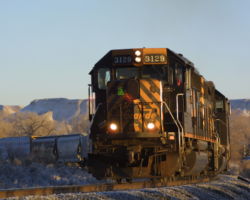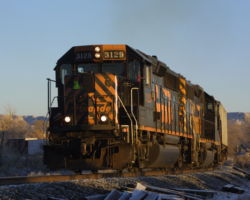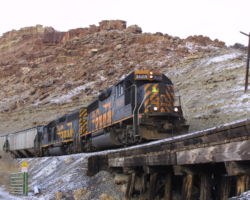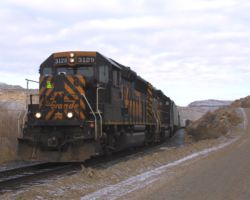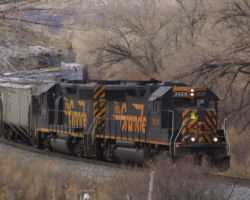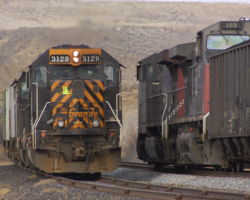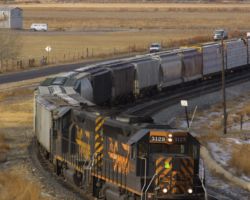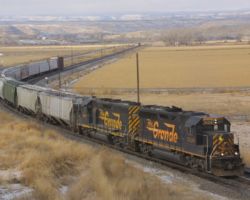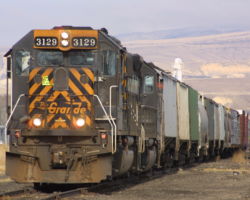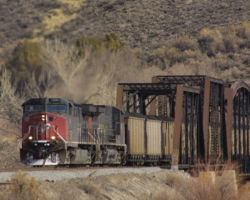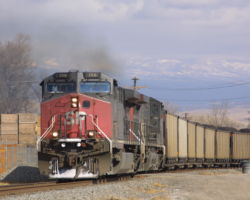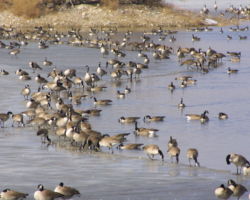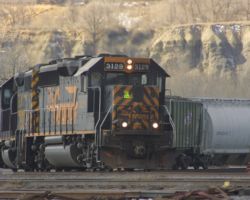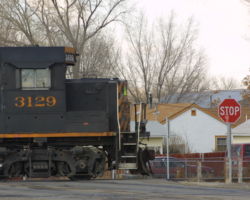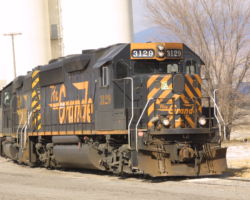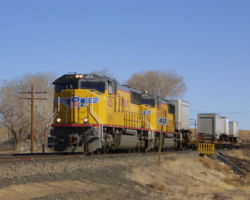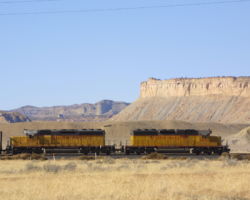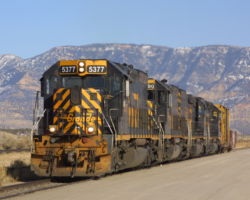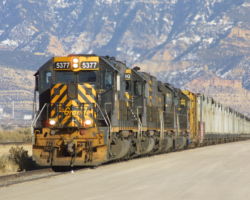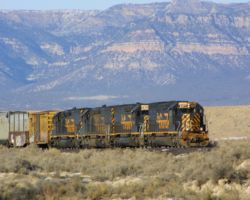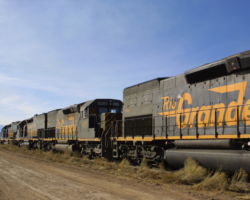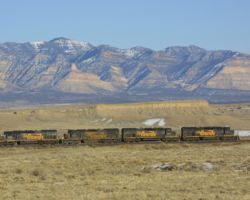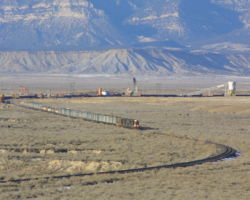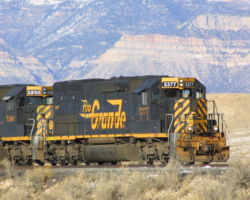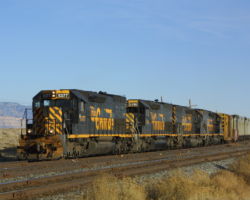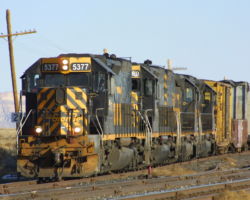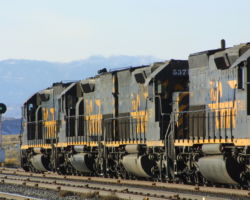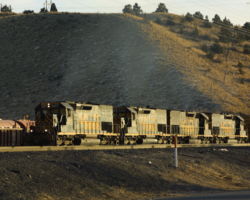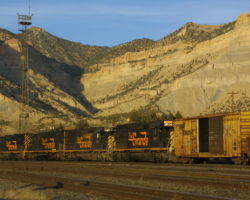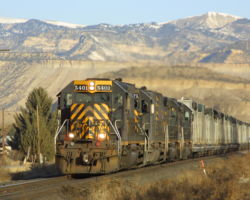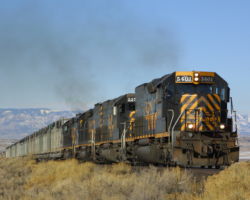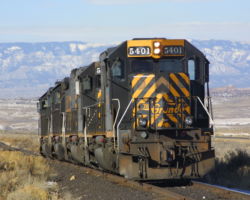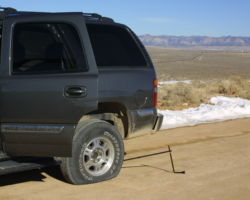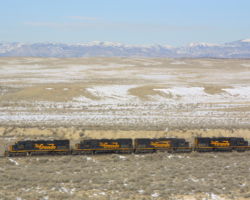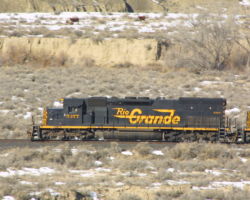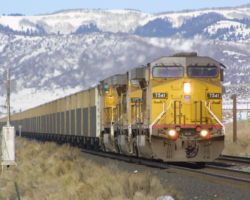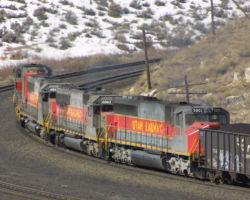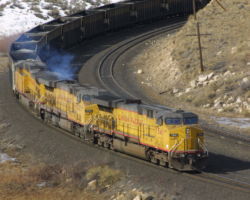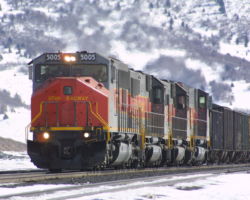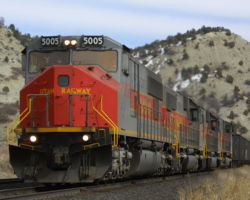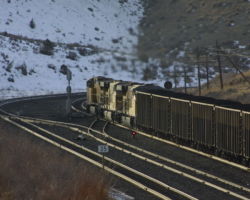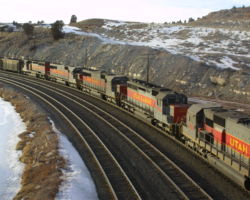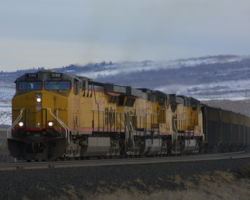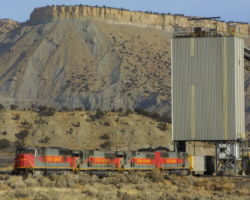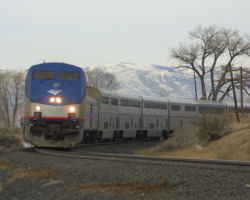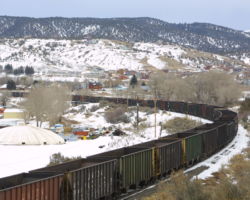The Montrose Local – Friday Feb 15, 2002
Thursday was one of the worst starts to a trip I’ve ever had. Imagine a trip that takes seven hours between Colorado Springs and Grand Junction, CO, with everything between Gypsum and GJ at normal speed (50-75ish, depending on the stretch). That gives you all an idea of just how slow the Colorado Springs – Vail Pass segment really was… Partly due to iced and snow-packed pavement, partly due to traffic density (how many of us crazy people are trying to cross the mountains tonight?), and partly due to wrecks slowing things down further, I think I averaged 35 the entire distance. Not bad, but not pretty, either. Finally arrived in Grand Junction around 2330h, and after fueling and washing the truck, I hit the bed to get as much sleep as possible before the next morning.
The Montrose Local seems to usually leave between 0630h – 0700h, so I figured waking up about a quarter ’til six should do it. As it turned out, I met the local as the gates came down in front of me, somewhere around 0630h. A bit earlier than I expected, but still well before daylight. Not very useful for photography, but at least I had some idea where the local was and what it was doing. Just as had been happening for several weeks now, DRGW 3129 was in the lead with DRGW 3097 following along behind. That was it – just two Grandes and perhaps 10-15 cars.
From my best guess (okay, my GPS told me, I’m just not nearly that talented), I had a predicted sunrise of just after 7, so I figured 0730h would be enough to get light over the mesas. Still, I headed down to Whitewater (milepost 13) to wait, just to keep track of it. I guess I’ve gotten spoiled on the eastern Moffat, where crews call every control point. In unfamiliar territory, I’m always concerned that the train somehow got past me… Usually it turns out I’m well ahead of the train, but there’s those few times I just don’t want to take the chance.
As it turned out, there was a M-o-W employee out with a hyrail truck between Grand Junction and Whitewater, and his track and time kept the local in the yard until 0700h, when he shortened up to milepost 13 to Bridgeport. Let’s see, 12 miles, 25mph speed limit, that gives an ETA of 0730h – perfect timing, if my guess on daylight was correct. Sure enough, right on cue, sunlight and 3129 both showed up around 0730h (in fact, within two minutes of each other – I could actually hear the train before I had direct sunlight – Photo #1). As a note, there’s a spectacular morning shot of northbounds coming out of the canyon from the Whitewater boat landing – useless in this case, but thought I’d make a note of it.
I’d intended the next stop to be Bridgeport, another 12 miles down the line. However, due to road construction, the road was blocked with a large piece of Caterpillar’s craftsmanship, some orange barrels, and something resembling a makeshift fence. Oh well, at that time of the morning, the light would have still been lousy that far down in the canyon. I should have known that…
The real next stop was somewhat of an experiment – road K50 off to the west of US 50. Supposedly it goes down to a point called Dominguez where it splits into two roads. However, all of those “towns” are more or less mythical – there’s nothing there but high desert and junctures in the road, sprinkled with the occasional structure. However, the right fork looked considerably more promising than the left fork, so away we went…
The right fork off the end of K50 is a narrow, winding little road that follows the railway north through the canyon. Eventually it comes to a stop at a gate marking private property just beyond a wooden railway trestle still marked “393.20” (from the old Rio Grande mainline’s mileposts). (For reference, the new milepost is somewhere around 30.3 and just after that talking detector.) A short wait later (it took me quite a while to find the spot) I managed to photograph the two working over the bridge. (Photo #2) At this point, I followed the local back to near Dominguez, where the road is perched on a narrow ledge just above the railway. I clicked off a few more (see the additional photos pages), and headed back for US Hwy 50.
I tried for another round of shots at the Escalante bridge, but missed the front end by about four cars. Blame road construction – the five minutes sitting and waiting on dirt-hauling trucks on US 50 didn’t help. At that point, it was on to Roubideau, where I’d guessed the DS was setting up a meet with a loaded coal train off the North Fork.
I arrived at Roubideau in time to actually get west/north of the siding. I’d never been west of the siding, and was quite surprised to see a short silver through-truss bridge in clear view of the road, not to mention a great S-curve. Not much time to think, though – 3129’s headlights could be seen peeking through the trees beyond the curve, and soon was over the bridge and slowing before the switch (Photo #3). After a quick meet with a loaded coal train (Photo #4), it was on to Delta for the day’s switching. (Photo #5)
This was one Montrose local that wasn’t actually going to Montrose. I’d hoped that it would, but the crew informed the dispatcher while receiving their work-between warrant that it was just Delta today. Unlike the last time I went out to watch the local, they switched the south end of the yard first (Photo #6), dropping the trailing boxcar at a lumberyard-like industry and moving some empties that were already there. While I went and got breakfast at the local McDonalds, they dropped off the rest of the consist. At that point, they were down to a handful of grain hoppers to be exchanged at the local elevator.
As I was plowing through my second hashbrown, though, the dispatcher was talking to SP 186 and crew, leading another westbound coal load approaching Delta. However, the DS couldn’t raise the crew of the local, and consequently 186 couldn’t get a track warrant through from milepost 57 through Delta. After finishing my greasy, starchy breakfast (Hey, I was hungry – there are a few things that override my railfanning urges…), I headed east to catch up with SP 186 and train.
I didn’t need to look far – just beyond Austin I saw headlights peering around a corner above the highway. On the drive over, I’d picked out a perfect spot just beyond a bridge. Nice, long section, great older truss bridge, and aligned just the right direction for the sunlight. (Photo #7) Still no response from 3129, so shortly after passing the spot where I was taking the photo, the crew bought SP 186 to a halt short of milepost 57.
At that point, I decided to head back to Delta to check on the local’s progress. While I was driving back, one of the maintenance personnel contacted the local’s crew, and the whole track warrant thing got worked out. SP 186 received the warrant to proceed through Delta, and the local pulled into the yard to wait. I caught 186 one more time coming through Delta (Photo #8), and then wandered over to the park to photograph the flocks of geese sitting on the frozen ponds. (Photo #9)
After SP 186 cleared Roubideau, the DS once again issued a work-between order for the local, and the crew backed out on the main and headed east (Photo #10) My day with the Montrose local ended shortly thereafter (around noon) with watching them switch the local elevator (Photo #11). After that, they’d be reassembling the train and heading north – which, with a southern winter sun, would provide nothing but an hour of lousy photo opportunities. At that point, I decided to head west towards Helper, UT.
Friday’s Dirt Train
I left Delta around 1200h, and headed west for Helper. No specific reason aside from not seeing any point to following the local back north. I’m sure the crew already thought I was completely nuts, and I didn’t feel any particular need to reinforce that notion. Upon arrival in Grand Junction, I filled the gas tank (again) and grabbed a quick lunch before heading out.
For those that don’t know, the Z trains have been gone from the ex-Rio Grande for six months or better, and at the beginning of February the two through manifests (MDVRO and MRODV) were also moved north to UP’s Wyoming line. The Z trains were temporarily moved back on to the Moffat for some unknown reason in February 2002, but will be moved back to Wyoming in March. Just before leaving town, I heard the DS setting up a meet between a westbound Z train (specifically, ZDVRO) and the eastbound Amtrak California Zephyr, probably at West Fruita. With February half over, I thought this would definitely be one to catch.
Unfortunately fate and the DOT had other plans – between Durham and Fruita on US 6 is a bridge that’s being replaced. The detour around the perhaps mile-long stretch is several miles at least, all at a 45mph speed limit. Just as I finally got through the detour and into the east side of Fruita, the distinctive headlight pattern of an Amtrak (pick one: P40/P42/ugly GE thing) coming under the bridge. Too late, too much time detouring, and Amtrak wasn’t running late enough. *grin* I still had a Z train in sight, though, but he was rapidly leaving the siding and my scanner just died. Amazing the little conflicts in life – between the need to get on the freeway to make time and the need to pull over, find the charger, and put new batteries in the scanner.
Obviously the batteries really couldn’t wait – the mainline west of Mack disappears down in the Colorado River canyons until near Westwater. Even then, it’s not exactly what I’d call accessible until Cisco – sure, there’s a BLM road from Westwater to Cisco, but even on a good dry week it’s rough and full of car-killing ruts. Still, being able to make almost 80 on the freeway, I figured I could probably catch the Z perhaps by Westwater or certainly by Cisco.
As usual, wrong again. The Z easily outran me to Westwater (in fact, I saw it go by when I was still probably two miles away), and with the time it took to get back on the freeway from Westwater I knew Cisco would be a loss, too. Sure enough, it would take until near Sagers, UT, before I’d even see him again.
Due to a short stretch of 40mph track and just pure luck, I got the first shot of the afternoon at Thompson, UT. (Photo #12) As you can see, it’s a rather lightly-loaded train – those four UPS trailers are it, aside from a string of empty flats and spine cars behind them. After the passage of the Z, I decided to just follow the old back road over to Brendel to rejoin the freeway. Upon arrival at Brendel, I found a rather-unexpected Potash local (Photo #13) sitting on the wye waiting for permission to enter the main. Based on previous experience, I’d assumed that at that time of the day (around 1330h) the Potash local was still out on the line, and had given a few passing thoughts to going to look for it. As later luck would have it, it was a good thing I didn’t.
I knew the Z wasn’t far ahead of me, but once the line turned north at Green River I more or less lost interest. Again, the light was from all the wrong directions, and a pair of SD70Ms pulling four trailers really just didn’t interest me that much. Well, okay, actually it probably had a great deal more to do with being tired from a full stomach and running on four hours of sleep from the previous night.
Coming in towards Wellington, I started thinking that just maybe I should check the Sunnyside branch. While I didn’t actually expect the Dirt Train to be out in the afternoon (as I’d never made it in to the Price area before around 1700h on any given Friday), I figured it would save me the time and lost opportunity of a trip back and a good deal of swearing when I got to Helper only to find there was nothing there. I was so busy looking out the window and down the line that I nearly missed spotting a much more important feature – a Utah State Trooper with his radar gun fixed on me at the bottom of the bridge over the branch. Oh well, I wasn’t that much over the limit, and he kindly left me alone to go after the guy behind me (who apparently was going much faster than I thought). Much to my surprise, though, I had seen lights clear down near the end of the line.
My initial reaction was that it was ECDC’s switcher out pushing cars around. Surely it couldn’t be a dirt train – just too much luck for that to be true. Imagine my amazement when I realized that it wasn’t just a dirt train, it was one with four matching, clean Rio Grande tunnel motors. Based on the trace information from the few days before, it looked as if the dirt trains were running with power other than SD40T-2s – only one of the tunnel motors had moved from Helper in days, according to the computer. Better yet, they were stopped while the crew on the ground opened some gates and threw a few switches. While I’m not sure exactly what happened, it looked like the local had already used the non-gated track to pick up a pair of cars (note the boxcar and gon), and was now preparing to retrieve the whole string of container cars from one of the gated tracks. (Photo #14). Within a few minutes, the crew had the train together and was heading out. (Photo #15) Talk about good timing on my part…
Since I’ve never had the opportunity to photograph a westbound dirt train before in decent light (I’ve never seen the afternoon version), I decided to follow the train down to Mounds, where the branch rejoins the mainline. Once the local got back on the main, it would be very hard to follow due to fairly high speeds, but the branch is limited to between 10-20 for its entire length. While dirt, the road to Mounds is in good shape and can be used to beat the train to Mounds while driving at safe, sane speeds. Not only that, but there are several shots along the way – such as overlooking the valley (Photo #17) and as the train approaches the steel trestle over the road (Photo #16/#18). One word of warning, though – this is open range land, and frozen cow pies on the road are hard as a (giant) rock and very jarring on the suspension of any vehicle, not to mention its occupants. Try not to hit them, or the cows that created them…
With no trains even remotely close by, the dispatcher gave 5377 the highball off the branch long before even arriving in Mounds. Within only a few minutes, the train ground around the corner (Photo #19/#20) and slowly began to wind onto the mainline (Photo #21). As soon as the trailing cars had cleared the switch, they were up to track speed and gone for Helper. I half-heartedly followed them through the desert on the BLM road that roughly parallels the tracks, but soon fell behind after having to wait for them to clear the grade crossing about halfway back to Wellington.
The sun was quickly slipping below the mesas, and so with the Olympic traffic taking many of the hotel rooms I decided to stop and check in at the National 9 Price – just to make sure I didn’t have to sleep in my truck for the next two days. Sure enough, the room was all ready, so after a brief restroom stop I headed towards Helper to just see the place one time before nightfall. As luck would have it, the returning dirt train had gone in the hole at Maxwell (halfway between Price and Helper) to wait for an eastbound, so I caught up with it just beyond the Helper yard limits. As it turns out, there was just a few minutes of light left, so I caught a couple of decent artsy shots before darkness set in (Photos #22-23). At that, I called it a day and headed for Price and dinner.
Saturday’s Dirt Train – Feb 16, 2002
Unlike the night before, I actually managed a full eight hours of sleep Friday night. That whole getting-in-when-you-expect-to thing helps considerably… Either way, Saturday started at about 0645h when my watch went off. While most watches wouldn’t wake me up, this one does a better job than any real alarm clock I’ve ever owned… Unfortunately the very loud dissonant tones that it uses typically don’t leave me in a very pleasant state, but turning the scanner on and hearing the morning’s dirt train being assembled definitely improved my mood.
I was out the door around 0730h, and just north of Price I heard the dispatcher mention that Saturday’s dirt train would have to wait on one that was just coming through Utah Railway Junction (URJ). I figured one train’s nearly as good as the next and the sun just broke over the mesa, so I stopped at a grade crossing south/east of Maxwell and waited. Almost right on cue, based on the distance he had to cover and track speed, the ZRODV rolled around the corner lead by none other than 4536 from yesterday’s ZDVRO. (Photo #24) Fortunately for Union Pacific, this one looked a bit more profitable, with a whole train full of UPS trailers.
As promised, the dirt train came out of the yard right behind ZRODV, and by the time it got to my position wasn’t following by more than five minutes. The sun, however, had grown a bit in intensity, producing much better photos than those of the Z just a few minutes before. (Photo #25) Yet another dirt train with all four tunnel motors on the front! With that, it was off to Mounds to try for a few shots. As best I could figure, I wasn’t going to make it, but thought at least I’d give it a try. There’s a great s-curve coming east into the West Mounds switch that would be perfect in the morning light…
Going down the road to Mounds, everything looked good. No sign of the train, and more helpfully no cows on the road. I actually got all the way down to the West Mounds switch, not noticing any sign of the train, and stared down the line in disbelief – surely I hadn’t smoked him by that much getting to Mounds. I expected it to be close, but looking out over the desert I couldn’t see a darn thing. Then I turned off the engine of the truck – and in the background was click-click… click-click… click-click… slowly moving away in the distance. Some days I love jointed rail, even when it tells me I’m a moron.
The train was so short that day that it fit in the blind spot where the Sunnyside Branch curves around the back of a hill to gain elevation. Even with my careful watching, dumb luck kept it just beyond my view the whole time. Even with a very speedy trip back up the road, 5401 and crew had too much of a lead – there’d be no shots between Mounds and Banning of the eastbound today.
With that in mind, I drove up towards Sunnyside and picked a good spot along the line. Good location defined as the photo wasn’t too bad, and the ditch wasn’t steep enough to roll the Yukon or muddy enough to sink it. More worried about sink than roll, but still – there’s a few spots out there that have darn steep embankments. There’s nothing like wandering through thick underbrush and snow to remind me of first the altitude and second how out of shape I’ve become in the last two years. The shot worked out nicely, though, and I grabbed photo #26.
The actual switching at Sunnyside was the quickest I’ve ever seen on this turn. Literally, it was run in, drop the string of cars, and leave. No strange cars to be spotted, just a simple matter of dropping the container flats, tying them down, and heading back. Within five minutes everything was done and the crew was starting on their return trip to Helper (Photo #27).
Since I now knew where the power was, I decided to head for Mounds again and try for a shot of the power moving west through the previously-mentioned s-curve. About halfway out to Mounds, though, there was that certain stomach-sinking bang! pssst… pssst… pssst… that can only mean one thing – I ran over something I shouldn’t have… By the time I got the truck stopped and opened the door to check on the tire, it was completely flat. Game over, no more photos of the dirt train for today – and it was even the tire I just had fixed the week before from another small leak. Nothing small about this one, though – a two-inch rip and slice clean through the tread, pretty much destroying the tire. I walked back and looked, but I still have no idea what did it. Perhaps just a rock I hit wrong, who knows. Still, it was a good twenty minutes later before everything was fixed up and I was back on the road. The only problem – no spare tires left. The only four I had I was using, so I headed back to Price to look for a replacement. I was off the backroads as soon as possible – at this point, I couldn’t afford to lose another one.
Making a little lemonade from lemons, though, I grabbed a couple photos from my vantage above the line – one just of the four motors (Photo #29), and then a few attempts at a motion-panning shot of 5377 (Photo #30).
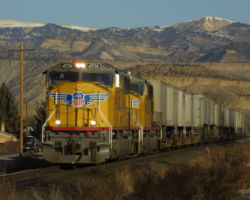
Saturday Afternoon and Sunday
After an hour-long and very futile search for a Firestone Wilderness AT 265/75/R16 tire in Price, UT, on a Saturday, I decided to give up, live dangerously, and run the rest of the trip with no spare. (I have no love for those soft, squishy, poor-handling Firestone tires – I’d rather have a set of Goodyears any day – but the spare has no miles on it, and with a new mate could provide a balanced set of rear tires until I was ready to replace them all. Unlike what I’m doing right now – one usual tire with 40k on it, one brand new spare.) Yes, I’m an idiot. Was there ever a doubt?
Relegating myself to the conclusion that there was no new tire to be found, I decided I might as well start doing what I’d come out here for – railfanning. One time between tire stores, I’d heard over the scanner that Utah 5005 was leading one through Utah Railway Junction (URJ) and up the hill. After grabbing one artery-choking Big Mac and the biggest dang Coke I could find (hey, it was a bad morning), out of town and up the hill I went.
There apparently were problems with the signalling at Lynn, as the dispatcher warned 5005 that he might have to stop short of the signal. However, the crew reported that the approach was green, and then the signal at Lynn was a highball, so they proceeded on to a red at Kyune. While I thought that was actually what I heard on the scanner, I could only see a few cars sticking out beyond the Kyune bridge from US 6, so I assumed that the train had moved on. Proceeding to Colton, I found a track inspector on the line where I expected the train, and I saw an eastbound empty coal drag working down from Soldier Summit.
Shortly thereafter the radio made it clear – the Utah was a short train and was stopped at Kyune, there was an eastbound heading for Colton, and the track inspector had found an open joint and just issued a 10mph slow order for the eastbound. The Utah would continue to wait until the eastbound had passed Colton, and then be crossed over. I waited for UP 7541 to show up at the grade crossing west of Colton (Photo #31), and then headed back to the hill overlooking Kyune. I caught the Utah 5005 and train just throttling up (Photo #32) (and saw the only other two fans for the weekend, watching the departure from the same hillside). As I was starting to drive off after the passage of the Utah train, UP 7541 came around the corner – well, darn, I forgot all about him! It’s amazing the “grab” shots you can get out the passenger window somedays… (Photo #33)
At this point, I decided my best bet was to follow 5005 up the hill and possibly down the other side. Heck, if I got far enough, there was probably a Firestone dealer in the Salt Lake valley. (Reminding myself that this was a railfanning trip, not a chance to get car parts…) On the way, I took another shot in the snow (and mud, and water) at Soldier Summit (Photo #34), along with the two other fans from Kyune.
Somewhere while driving west I decided I’d really rather head back towards Helper than on towards Provo. The clouds were starting to set in, turning the everything cold and washed out. I set up for one more shot near the detector beyond Detour (Photo #35), and then turned back for Helper. I didn’t find anything else moving on the way down the line, and the scanner was completely silent the whole time. Somewhat out of frustration, I went back to my hotel room to take a nap.
Even though I was half asleep, I did hear the scanner break to life again around 1530h. Something about UP xxxx leaving URJ westbound. It wasn’t an afternoon tunnel motor run like I’d been hoping for (hey, I didn’t think it would happen, but you can’t stop me from hoping…), but it at least was some moving train. That’s better than nothing, or sitting around the hotel room.
As it turned out, the train in question was the IPPX empty I’d seen earlier, except this time freshly loaded out of Wildcat. The other odd thing was that it didn’t have DPU – it had manned helpers. I assumed it was a Union Pacific train because of the three AC6000s on the front, but apparently it was just run-through power as there was a whole set of Utah units pushing away about two-thirds of the way back. I’d only wished it was a UP train, and wondered why a small gaggle of tunnel motors couldn’t be there instead. Nonetheless, with it being late in the day, I quickly got in front of it and looked for spots with light – Kyune and Colton were the first two to come to mind.
Sure enough, Kyune still had light east of the bridge. It did seem to take approximately forever for the the westbound to show, eventually he did just a few minutes before the light was gone for the day. There’s not much to say about the photos, aside from that Photo #36 is the lead power at the West Kyune switches, and #37 is that small fleet of Utah helpers. For referece, the Utahs are, in order: 9005, 6060, 6061, 9004, 6064, 5004. After continuing west and freezing at Colton (Photo #38) for another twenty minutes while they removed the helpers, I clicked off a few more shots and headed for the motel for a night. Not a bad day after all, no matter how many tires I killed. 🙂
Sunday morning dawned fairly cloudly and dreary, but it looked a bit more sunny up towards Helper. I figured I’d go check things out, just to make sure there wasn’t going to be a Sunday dirt train or something like that. (The dirt train, as far as I know, doesn’t run on Sundays, but there is a local for switching Price and the Castle Valley (CV) spur, usually late on Sunday night.) While Helper proper was pretty dead, I did find a Utah just preparing to load at the Wildcat loadout. (Photo #39) Figuring that loading would take a couple hours at least, I decided it wasn’t worth the wait with the clouds rolling in, and headed towards Wellington and home.
The only thing I actually saw moving on the way home was a meet between Amtrak’s #6 (the eastbound California Zephyr) and a westbound BNSF at Wellington, UT. (Photo #40) After that, it was wide open trackage all the way back to Dotsero, CO. I did stop to photograph some of the stored cars on the old Tennessee Pass mainline between Gypsum and Wolcott (Photo #41), but other than that it was a pretty straight shot home.
All shots in this trip report were taken with a Canon EOS D30 with a Tamron 28-300mm F3.5-6.3.
This work is copyright 2024 by Nathan D. Holmes, but all text and images are licensed and reusable under a Creative Commons Attribution-NonCommercial-ShareAlike license. Basically you’re welcome to use any of this as long as it’s not for commercial purposes, you credit me as the source, and you share any derivative works under the same license. I’d encourage others to consider similar licenses for their works.
